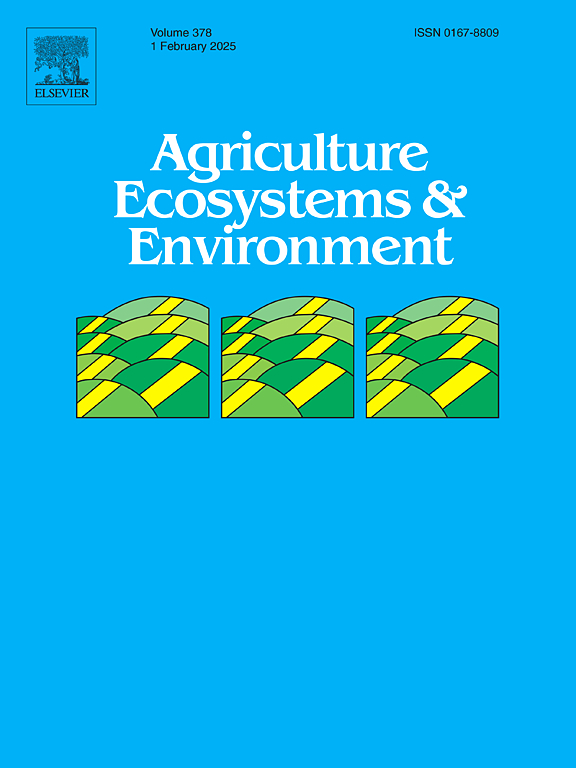Field assessment of sequential herbicide mixtures on nitrogen cycle-related functions in soybean production
IF 6
1区 农林科学
Q1 AGRICULTURE, MULTIDISCIPLINARY
引用次数: 0
Abstract
Herbicide applications worldwide generally intend to protect crop yields from weed interference while avoiding mechanical disturbance in the topsoil layer. Their intensive use often leads to cocktails of chemicals in soils, which may interfere with natural soil functions, and productivity. The effects of a sequence of herbicides typically used in soybean crops were tested on different endpoints related to the nitrogen cycle. The field experiment was repeated in 2020–2021 and 2021–2022, from fallow to harvest time of the soybean crop. The treatments were: a control without herbicides, a sequence of three herbicide applications at the label recommended rate, all the six possible combinations of the three herbicide applications, and a treatment with the typical, complete scheme but at twice the recommended rate. The first application was a mixture of glyphosate, dicamba, and clethodim; the second was a mixture of glyphosate, S-metolachlor, and flumioxazin, and the third herbicide application moment included fomesafen only. All the treatments remained weed-free, either by herbicides or manual removal. Significant negative effects were detected for nodulation in some treatments at the vegetative stage compared to the control, but no dose-dependent response was observed. Plant biomass and nodulation were not significantly related to herbicide mixtures at the reproductive stage, nor was the soybean yield at harvest time. These results engender a complex scenario for farmers to fully grasp the potential risks associated with the use of herbicides. However, potential nitrification was affected after the third herbicide application moment in the first year of the experiment, in all the treatments exposed to at least one herbicide application, while the abundance of ammonia oxidizers showed no effects. This comprehensive field assessment is relevant to evaluate herbicide environmental risks, accounting for plant-microbiome interactions under real pedo-climatic conditions and stress factors.
实地评估连续除草剂混合物对大豆生产中氮循环相关功能的影响
世界各地使用除草剂的目的通常是保护作物产量不受杂草干扰,同时避免对表土层造成机械干扰。除草剂的大量使用往往会导致土壤中化学物质的堆积,从而干扰土壤的自然功能和生产力。我们测试了一系列通常用于大豆作物的除草剂对氮循环相关终点的影响。2020-2021 年和 2021-2022 年,从大豆作物休耕到收获期间,重复进行了田间试验。处理方法包括:不施用除草剂的对照组、按标签建议用量连续施用三次除草剂、施用三种除草剂的所有六种可能组合,以及采用典型的完整方案但用量是建议用量两倍的处理。第一次施用的除草剂是草甘膦、麦草畏和 clethodim 的混合物;第二次施用的除草剂是草甘膦、S-甲草胺和氟磺胺草醚的混合物;第三次施用的除草剂仅包括福美双。通过除草剂或人工清除,所有处理都保持了无杂草状态。与对照组相比,某些处理在无性生长阶段对拔节有显著的负面影响,但没有观察到剂量依赖性反应。在生育期,植物生物量和结节与除草剂混合物没有显著关系,收获时的大豆产量也是如此。这些结果给农民带来了复杂的情景,使他们无法充分把握使用除草剂的潜在风险。不过,在实验的第一年,所有至少施用过一次除草剂的处理中,在第三次施用除草剂之后,潜在的硝化作用都受到了影响,而氨氧化剂的丰度则没有受到影响。这一全面的实地评估与评估除草剂的环境风险有关,考虑到了真实气候条件和压力因素下植物与微生物组之间的相互作用。
本文章由计算机程序翻译,如有差异,请以英文原文为准。
求助全文
约1分钟内获得全文
求助全文
来源期刊

Agriculture, Ecosystems & Environment
环境科学-环境科学
CiteScore
11.70
自引率
9.10%
发文量
392
审稿时长
26 days
期刊介绍:
Agriculture, Ecosystems and Environment publishes scientific articles dealing with the interface between agroecosystems and the natural environment, specifically how agriculture influences the environment and how changes in that environment impact agroecosystems. Preference is given to papers from experimental and observational research at the field, system or landscape level, from studies that enhance our understanding of processes using data-based biophysical modelling, and papers that bridge scientific disciplines and integrate knowledge. All papers should be placed in an international or wide comparative context.
 求助内容:
求助内容: 应助结果提醒方式:
应助结果提醒方式:


